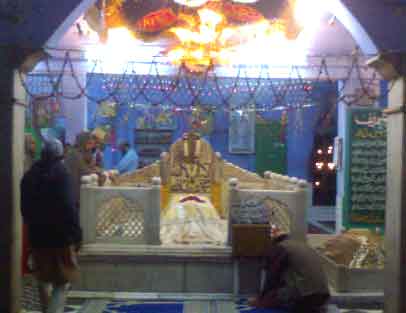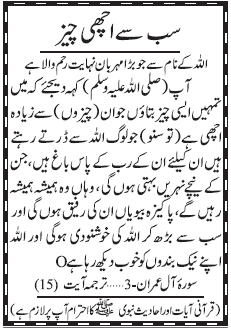HAZRAT SHAH KALEEM-ULLAH JAHANABADI R.A
(D. 1142/1729)

Hazrat Shah Kaleem-ullah Jahanabadi was grandson of Ustad Ahmed, the architect of Taj Mahal, and lived in shah jahan's newly founded capital, Shahjahanabad or simply Jahanabad. Hence Jahanabadi, where he commanded much respect as a sufi. The span of his long lif coincided with Aurangzeb' compaigning career in the Deccan and he died after crossing the age of eighty in the reign of Muhammad Shah.
Hazrat Shah Kaleem-ullah Jahanabadi established a madrasa there which attracted a large number of students from far and wide who enjoyed free board and lodging. The Sufi Poet Mirza Mazhar Jan-e-Janan once saw him teaching the Sahih of Al-Bukhari to students in this madrasa, which probably formed part of the mosque in which he stayed. According to Mirza Muhammad Akhtar Gurgani (Tadhkira-i-Awlia-e-Hind wa pakistan), Lahore 1954, ii 272), the emperor Aurangzeb later ordered the construction of a Khankah for him.
According to the same author the emperor Muhammad Muazzam Bahadur shah I(q.v.) became his disciple in his fourth regnal year(1123/1711), while engaged in an expediation against the rebellious Sikh under Banda Bayragi. Shah Kaleem ullah R.A led a life of ansterity, Farrukh siyar(q.v). As a rule, he discouraged his disciples from coming close to the rulers and kings and even exhorted them not to approach or visit them.
As against Ahmed Sirhindi(q.v), he favoured keeping good relations with the non-muslims so that they might be impressed with teaching of islam. All of his life he struggled for the glory and spread of islam but like Shah Waliullah Dihlwai, his successor in the field, his efforts met with little success.
Khuwaja Kaleem ullah acquired his early education from local scholars,including Abu-l-rida Muhammad, uncle of Shah Waliullah Dehlawi. Latter, he left for Hidjaz to make the Haj and zyara and stayed there for long time.
As a young man, he passed a few years in the holy cityies Mecca and Madinah and was educated by teachers who infused him with greater fondness for sufism than making him a theolgoian. During his stay in the Hijaz, he was initiated into the Naqshbandi and qadiri orders by Mir Muhtaram and Shaikh Muhammad Ghayass. On his return to Delhi he stayed in a mosque situated between the Red Fort and the Jami masjid in the quarter. In Delhi, his residence was situated in Khanum-bazar, a bustling locality between the Red Fort and the capital's congregation mosque, Jami Masjid; and he was buried in his own house after death. The British occupation forces at the time of supperssing the Revolt of 1857 razed the entire area to the ground. Only the grave of Shah Kaleem ullah was left in its place, perhaps, as a mark of respect for his saintliness. The Shah had formal links, as customary during his days, with all the sufi orders current india; but he was essentially a chishti in his leanings and loyalties. The Chishti sufis being conciliatory in their attitude towards the Hindu systems of vedanta and yoga, Shah Kaleem ullah followed the convention by accepting the Hindus as his disciples. As regards the Shi'ahs, none of them was practically initiated into the order by him, but unlike Shah Waliullah (d 1174/1762) and Shah Abdul-aziz(d 1239/1824) , Shah kaleem ullah overtly avoided polemical debates agains them.
Maintaining the practice of Chishti saints, who kept aloof from sectarian controvarersies, he moved a step forward and advised friendliness with the Shi'ah community. His views on other sufi practices were similar to those of his Chishti predeccessors. He approved sama - sufi music, zikr -recollection of Divine name, muraqibah -contemplation, and habs-i-nafs -breath control. Regarding the habs-i-nafs, some sufi orders invented an interesting legend, surely, to emphasize its independent rather islamic origin. They said Khizr, the prophet, blessed by God with everlastingness, and living hidden from common sight, taught the device to an early sufi, Khwaja AbdulKhaliq Ghujduwani (d. 575 / 1179). Ghujduwan being a village near Bukhara. So, it was his legacy. Nonetheless, the Chishti sufis, in their open-mindedness, did not bother giving its credit to the Hindu yogis. Shah Kaleem ullah, an arduous writer, for. thirty-two treatises in Arabic and Persian were ascribed to his authorship, concerned himself all his life with matters of interest to the sufis. The numbers of his surviving books being not less than nine, two of them have sustaind the attention of scholars: 1 discourses on miscellaneous subject, Kashkol-i-Kaleemi and and 2. collection of letters, Maktubat-i-Kaleemi.
He died on 24th Rabi ul awwal , 1142/17th oct. 1720 at an advanced age. the year of his death has been variously given as 1140/1727, 1141/1728(ef. Nuzhat al Khawatir, Vi. 241), 1142/1729 (appendix to sawa'al-sabil, 139) and 1143/1730 as given by Ghulam Ali Azad Bilgrami (ef. ma-cathir al-kiram, i, hyderabad 1910, 42).
The Year 1142/1729 has been adopted as the most reliable one, as many authorities agree thereon. After the mutiny of 1857, the entire quarter wherein stood his khankah was pulled down by the british but his grave was spared. It had remained in a state of neglect and disrepair for some decades when Khwadia Ghulam Farid, spiritual guide of the ruler of Bahawalpur, contributed a large sum for its reconstruction.
It was later repaired and renovated by one of his descendants, who set up a beautifully carved stone railing around his grave and paved the tome floor with marble flags. The tomb still exists and is the lonely structure standing between the Red Fort and the Jami Masjid. An Urs is held every year at his tomb on the occasion of the aniversary of his death. It was regularly attended by the last Mughal Emperor of Delhi Bahadur Shah Zafar and other princes of the royal family.
His leading Khalifa was Nizamuddin Aurangabadi to whom he addressed a number of letters on the problems of tasawwuf. He left three sons and three daughters. His sons, however, all minors at the time of his death.





 This is a free homepage created with page4. Get your own on www.page4.com
This is a free homepage created with page4. Get your own on www.page4.com